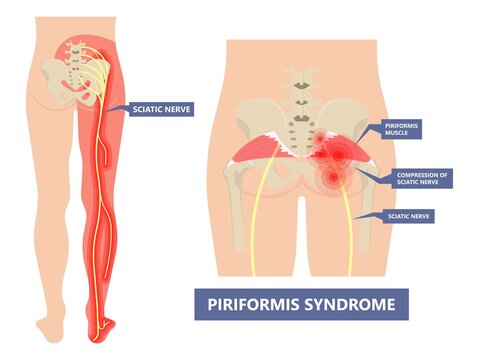What Is Piriformis Syndrome? - 3D Muscle Lab

View Details :both" id="content-section-0">Piriformis syndrome: Symptoms, diagnosis, and treatment - Truths

The sciatic nerve travels through the pelvis, passing under the front surface of the piriformis muscle as it takes a trip through the pelvis. It then cuts into 2 branches prior to decreasing each leg, branching off at the back of the knee to divide into the tibial and peroneal nerves, both of which supply the lower leg and foot.

Piriformis Syndrome Exercises Explained - PhysioRoom Blog

Buttock Pain & Piriformis Syndrome
The sciatic nerve is accountable for flexing the knee, bringing the thighs together (adduction), and flexing and extending the ankles and toes. It also provides sensation to the back of the thigh, the entire lower leg, the ankle, and the sole of the foot. The piriformis muscle originates at the front of the sacrum near the sacroiliac joint pill and connects to a bony knob on the thigh (thigh bone) at the outer part of the hip.
It likewise uses stability while strolling, running and standing. Usually, the sciatic nerve passes directly underneath the piriformis before continuing down the back of the thigh. But for some, the sciatic nerve passes directly through the piriformis inclining such individuals to piriformis syndrome, which might also be described as piriformis sciatica (rather than real, or discogenic, sciatica).

Piriformis Syndrome and Sciatica - Complete Orthopedics - Multiple NY Locations
The Only Guide to Piriformis Syndrome Treatment in The Woodlands & Houston
Keeping that position for long durations can trigger pain that radiates down one leg. Other signs may consist of: Pain in the opposite sacroiliac joint Pain with sitting standing or strolling for more than 20 minutes Intense pain with sitting or crouching Pain and/or paresthesia (pins and needles, tingling, burning, tingling, or itching sensations) radiating from the sacrum down the back of the thigh, usually stopping above the knee Pain that improves with movement Pain when standing up from seated or crouching Foot tingling That's why it's so simple to error piriformis syndrome for sciatica; they have a lot of the exact same symptoms.
This is referred to as primary piriformis syndrome and happens when you have a split piriformis muscle, split sciatic nerve, and/or an atypical sciatic nerve course. Secondary piriformis syndrome is much more typical and is caused inflammation of soft tissues, muscle convulsion or both, resulting in nerve compression. Direct trauma to the butt can result in swelling, scarring and contractures of the piriformis muscle This may be the outcome of a significant occasion like an automobile accident or a fall.
